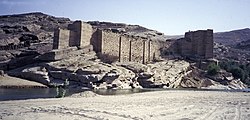
Back مملكة أوسان Arabic مملكة اوسان ARZ Əvsan padşahlığı Azerbaijani Awsan Catalan Ausan German Βασίλειο του Αουσάν Greek Awsan Spanish Royaume d'Awsân French Kraljevstvo Ausan Croatian Awsan Italian
Kingdom of Awsan | |||||||
|---|---|---|---|---|---|---|---|
| 8th century BC–7th century BC | |||||||
 | |||||||
| Capital | Ḥajar Yaḥirr | ||||||
| Common languages | Old South Arabian | ||||||
| Religion | Arabian paganism | ||||||
| History | |||||||
• Established | 8th century BC | ||||||
• Disestablished | 7th century BC | ||||||
| |||||||
| Today part of | Yemen | ||||||
| Part of a series on the |
| History of Yemen |
|---|
|
|
The Kingdom of Awsan, commonly known simply as Awsan (Qatabanian: 𐩱𐩥𐩯𐩬, romanized: ʾwsn; Arabic: أوسان, romanized: ʾAwsān), was a kingdom in Ancient South Arabia, centered around a wadi called the Wadi Markha. The wadi remains archaeologically unexplored.[1] The name of the capital of Awsan is unknown, but it is assumed to be the tell that is today known as Hagar Yahirr (locally named Ḥajar Asfal), the largest settlement in the wadi. Hagar Yahirr was 15 hectares and surrounded by an irrigated area of nearly 7,000 hectares, indicating that it was a formidable power in its time.[2] The main god of Awsan was called Balu (blw).[1]
The Kingdom of Awsan experienced two main periods of activity. The first began in the 8th century BC, and in this time, Awsan was militarily allied with the Kingdom of Saba and, together, launched campaigns against common enemies. In the late 7th century BC, this alliance changed into a rivalry and Saba, under Karib'il Watar, obliterated Awsan, then ruled by a king named Murattaʿ. The later kingdom of Awsan experienced a resurgence around or after the 2nd century BC, its independence waning and waxing against Qatabanic control of the area.[3]
- ^ a b Avanzini 2016, p. 110.
- ^ Nebes 2023, p. 342.
- ^ Avanzini 2016, p. 201.
© MMXXIII Rich X Search. We shall prevail. All rights reserved. Rich X Search



